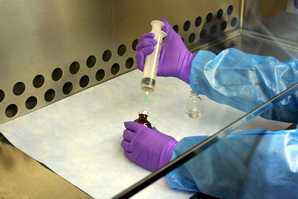NIOSH List of Hazardous Drugs in Healthcare Settings Allows Healthcare Workers to Minimize Exposure and Reduce Health Risks
August 2011
DHHS (NIOSH) Publication Number 2011-189

Compounding a hazardous drug in a biological safety cabinet.
A Story of Impact:
Modern society is fortunate to have powerful treatments available for a wide range of medical conditions. However, some useful medications can also have serious side effects. When using these drugs for medical treatment, doctors carefully control the dose and monitor the patient to minimize harmful consequences. But the doctors, nurses, pharmacists, and other healthcare workers who handle these medications are also being exposed and may also demonstrate adverse health effects.1
Hazardous drugs include drugs used for chemotherapy, antiviral drugs, hormones, and some immunosuppressant drugs—all of which may have damaging effects on the body. When these drugs must be prepared and administered, there are workplace best practices that can minimize potentially harmful exposure. These include the use of engineering controls such as biological safety cabinets, closed system transfer devices, needleless systems, and personal protective equipment such as gloves, masks, and gowns. In order to use this equipment appropriately and effectively, healthcare workers need to know which drugs pose a hazard.2
Starting in 2000, the National Institute for Occupational Safety and Health (NIOSH) began working with multiple partners and stakeholders to address the issue of occupational exposure to hazardous drugs. The NIOSH Hazardous Drug Committee—with representatives from nursing and pharmacy professional associations, federal agencies, pharmaceutical companies, health and safety professionals, manufacturers of safety equipment, and academia—developed recommendations for how to minimize exposure when working with hazardous drugs.
Relevant Information
- Exposure to hazardous drugs may occur through inhalation, skin absorption, ingestion, or injection.6
- Adverse health effects from hazardous drug exposure may include harm to internal organs, damage to the reproductive system, genetic damage, birth defects, and cancer.6
- About 8 million U.S. healthcare workers are potentially exposed to hazardous drugs, including pharmacy and nursing personnel, physicians, environmental services workers, workers in research laboratories, veterinary care workers, and shipping and receiving personnel.7
Impact
In order to disseminate these recommendations, in 2004 NIOSH published a NIOSH Alert and list of hazardous drugs with active input from partners in the healthcare industry, the pharmaceutical industry, and federal agencies. The list was updated in 2010 and will be updated periodically as new drugs become available. This list is a unique resource—the only current government-supported list of hazardous drugs in the U.S.—and is heavily referenced by workers throughout the healthcare industry. Since 2004 the website containing this information has been accessed over 200,000 times, with 27,000 of these visits in the 9 month period from October 2010 to June 2011.3
The value of this NIOSH Alert and list is demonstrated by the response it has received. In April 2011 the state of Washington passed legislation directing the Washington Department of Labor and Industry to use this information as the basis for statewide rules on the handling of hazardous drugs.4 In that same month, a joint letter was issued by the Occupational Safety and Health Administration, The Joint Commission, and NIOSH to all hospitals and healthcare employers in the nation. The letter describes the NIOSH Alert and hazardous drug list, and encourages employers to use this resource to protect their employees.5 Because this information is easily accessible here, healthcare workers can become active collaborators with employers in reducing their exposure to these occupational hazards, decreasing risks to their own health while they care for the health of others.
View/Download Entire Document: NIOSH List of Hazardous Drugs in Healthcare Settings Allows Healthcare Workers to Minimize Exposure and Reduce Health Risks [PDF - 758 KB]




Authors of the NIOSH List of Antineoplastic and Other Hazardous Drugs in Healthcare Settings—Barbara MacKenzie, Thomas Connor, D. Gayle DeBord, James O’Callaghan, and Douglas Trout; NIOSH—received a 2011 Bullard-Sherwood r2p Award in the Knowledge category.
References
1 NIOSH [2004]. NIOSH Alert: preventing occupational exposure to antioneoplastic and other hazardous drugs in healthcare settings. Cincinnati, OH: U.S. Department of Health and Human Services, Centers for Disease Control and Prevention, National Institute for Occupational Safety and Health, DHHS (NIOSH) Publication Number 2004-165. [http://www.cdc.gov/niosh/docs/2004-165/]
2 NIOSH [2010]. NIOSH Alert: NIOSH list of antineoplastic and other hazardous drugs in healthcare settings 2010. Cincinnati, OH: U.S. Department of Health and Human Services, Centers for Disease Control and Prevention, National Institute for Occupational Safety and Health, DHHS (NIOSH) Publication Number 2010-167. [http://www.cdc.gov/niosh/docs/2010-167/pdfs/2010-167.pdf]
3 NIOSH [2011]. Omniture SiteCatalyst Web Data retrieved June 6, 2011.
4 National Safety Council [2011]. Law protects Washington State healthcare workers from hazardous drugs [http://www.nsc.org/safetyhealth/Pages/LawprotectsWashingtonstatehealthcareworkers
fromhazardousdrugs_4.20.11.aspx]. Date accessed: May 20, 2011.
5 Joint Commission Online [2011]. Help for handling hazardous drugs from the Joint Commission, NIOSH, and OSHA
6 NIOSH [2007]. Medical surveillance for health care workers exposed to hazardous drugs. Cincinnati, OH: U.S. Department of Health and Human Services, Centers for Disease Control and Prevention, National Institute for Occupational Safety and Health, DHHS (NIOSH) Publication Number 2007-117. [http://www.cdc.gov/niosh/docs/wp-solutions/2007-117/pdfs/2007-117.pdf]
7 BLS [2010]. National industry-specific occupational employment and wage estimates, May 2010. Washington, DC: U.S. Department of Labor, Bureau of Labor Statistics, Safety and Health Statistics Program [http://www.bls.gov/oes/2010/may/naics2_62.htm].
SAFER • HEALTHIER • PEOPLE™
- Page last reviewed: June 6, 2014
- Page last updated: June 6, 2014
- Content source:
- National Institute for Occupational Safety and Health Education and Information Division


 ShareCompartir
ShareCompartir